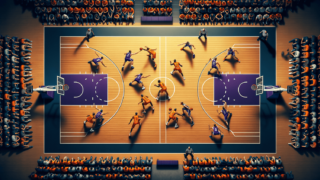
Welcome to a deep dive into the fascinating world of zone defense in basketball! Are you ready to uncover the strategies that make this key defensive approach both exciting and effective? In today’s post, we’ll be exploring everything there is to know about zone defense – from its origins, to the principles that govern it, and its numerous variations deployed by teams at all levels. By the end of this thrilling tutorial, you’ll have the playbook smarts of a pro, ready to analyze and discuss zone defense with court-side confidence. So, lace up your sneakers, put your game face on, and let’s jump right into it!
What Is a Zone Defense in Basketball?
A zone defense in basketball is a defensive strategy where players guard specific areas, or zones, on the court rather than defending individual opponents. This approach allows the defensive team to better protect key areas of the floor, such as the paint and the perimeter, forcing the offense to adjust and take lower quality shots. By working as a cohesive unit, the team can efficiently cover their zones, challenge shots, and reduce penetration opportunities for their adversaries.
Understanding the Fundamentals of Zone Defense
Before we dive into the nitty-gritty of zone defense, it’s crucial to grasp some fundamental concepts. Basketball, as a game, involves two crucial aspects – offense and defense. While offense focuses on scoring points, defense is all about preventing the opponents from doing just that. Zone defense is a time-tested strategy to accomplish the latter, and here’s a breakdown of the basic principles:
Team-Based Cooperation
Rather than having each player guarding a specific opponent in a man-to-man defense, zone defense relies on players working together as a collective unit. They communicate effectively, exchange roles, and cover for each other in a seamless manner. As you’ll see, this teamwork can wreak havoc on the opponent’s offense.
Area Coverage
In zone defense, players are responsible for designated areas instead of single players. They need to read the offense and be fully aware of their zones, maintaining a balance between them. Proper court positioning is crucial, and good zone defenders excel at keeping one eye on their zone and the other on the ball.
Forcing Tough Shots
By efficiently covering their zones, defenders can force the offense into suboptimal shots from low-percentage areas on the court. When properly executed, a zone defense can steer offensive teams away from their planned strategy and create chaos in their offensive structure.
Popular Variations of Zone Defense
There are several popular variations of zone defense that teams utilize based on their skillsets and the strengths and weaknesses of their opponents. Each variation has its unique characteristics, but they all spring from the principles outlined above.
2-3 Zone Defense
The 2-3 zone defense is a classic basketball strategy deployed by numerous teams at all levels of play. In this approach, two guards are positioned near the top of the key, while three forwards fan out across the baseline. Together, they form a shape resembling a “W”.
The 2-3 zone’s primary goal is to protect the paint by having the center player block opponents from directly attacking the basket. The guards and forward players also work in tandem to challenge perimeter shots and deny open lanes. Known for its balance and versatility, the 2-3 zone is regarded by many as the most fundamental of all zone defenses.
3-2 Zone Defense
The 3-2 (a.k.a 1-2-2) zone defense is another popular variation often employed to neutralize strong perimeter shooting teams. Three players align themselves along the perimeter, while two others stay positioned in the low post area. The goal here is not just to shield the paint but also to deny and contest outside shots.
The 3-2 zone can be quite aggressive, with players extending their coverage to limit the open three-point shots. It can be a highly effective scheme when the personnel is quick, athletic, and alert, making it increasingly difficult for opposing teams to find open shots.
1-3-1 Zone Defense
The 1-3-1 zone defense is an aggressive and unorthodox style designed to throw off offenses with its unique formation. One player covers the point, three players line up across the mid-court, and another one occupies the baseline area.
This defense’s high-pressure approach creates turnovers by double-teaming the ball handler and trapping at the corners. Fueled by the strengths of its center player as an intimidating shot blocker or the wing players’ length and athleticism, the 1-3-1 zone can be a potent weapon in a coach’s arsenal when executed to perfection.
Recognizing the Pros and Cons of Zone Defense
As with any strategic approach in basketball, zone defense has its ups and downs. Let’s explore the advantages and disadvantages associated with this popular defensive scheme.
Advantages
- Team Effort: Zone defense promotes teamwork and communication among the players, helping to build a sense of cohesion over time.
- Disrupting Offenses: A well-executed zone can disrupt offensive sets, causing confusion and forcing opponents into lower-percentage shots.
- Conserving Energy: By staying within their zones, players can save energy by not having to chase their opponents across the entire court.
- Versatility: Teams can adjust their zone schemes during a game to counter various offenses, adding an element of surprise and adaptability.
Disadvantages
- Rebounding Struggles: Zone defense can make boxing out and securing rebounds more difficult due to the lack of individually-assigned players.
- Vulnerable to Perimeter Shooting: If not played aggressively, zone defense can allow for open shots from the perimeter, especially against strong shooting teams.
- Lack of Accountability: In man-to-man defenses, players are held accountable for their assigned opponents, while zone defense can sometimes lead to finger-pointing among teammates when mistakes occur.
Mastering the Art of Zone Defense in Basketball
Comprehending and implementing a zone defense takes practice, dedication, and a keen sense of teamwork. Here are some tips to help you become adept at playing zone defense:
Develop Communication Skills
Start by enhancing your communication, both on and off the court. Players within a zone defense must function as one unit, which means constant communication is a must. Talk with your teammates, call out screens, share information, and keep each other accountable.
Master the Fundamentals
Ensure that you and your teammates have a solid grasp of the fundamental elements of your chosen zone defense scheme. Observe and analyze your opponents to determine the suitable variation that would give your team a competitive edge.
Be Active and Alert
Zone defense players need to be constantly on the move, anticipating passes, adjusting to ball handler changes, and switching between zones. By staying active and maintaining court awareness, you and your teammates will be more effective in neutralizing your opponents’ offense.
Override Predictability
Zone defense can fall into the trap of predictability if the opponents recognize the pattern. Mix up your team’s coverage by blending different zone schemes or incorporating man-to-man elements to keep the offense guessing.
Watch and Learn
Watch professional basketball games where teams employ zone defenses effectively. Observe their execution, anticipate their actions, and attempt to adopt their techniques in your own games. Learning from the best is a proven pathway to success.
Wrapping It Up
There you have it – an in-depth look at the exciting world of zone defense in basketball. By practicing various techniques and adopting the right mindset, basketball players can gain an edge in both individual and team performance. Commit to learning, communicating, and consistently refining your zone defensive skills, and you’ll be on the path to becoming a formidable force on the defensive side of the court. Now go ahead and put these insights to good use – hustle, swipe, smother, and ultimately… win!
Countering Zone Defense with Effective Offense
Now that we’ve thoroughly explored the intricacies of zone defense in basketball, it’s worth considering the strategies that can be employed to defeat it. While zone defense can confuse and frustrate offenses, there are techniques an offensive team can use to dismantle and exploit a zone-based defensive approach.
Passing Accurately and Quickly
Quick and precise passes can keep a zone defense on its heels by moving the ball around the court effectively. Accurate passing helps create open shots by catching defenders out of position or forcing them to scramble and adjust, leaving gaps for the offensive team to exploit.
Driving and Kicking
Another effective approach to capitalizing on zone defense weaknesses involves purposeful player movement. If an offensive player drives into a zone and draws multiple defenders, they can kick the ball back out to an open teammate for an uncontested shot. This tactic capitalizes on the reduced man-to-man responsibility of a zone defense strategy.
Screening the Zone
Although screens are more common against man-to-man defenses, they can also play an essential role in dismantling a zone defense. By setting a well-timed screen on a zone defender, offensive players can gain some separation and force the defense to rotate, creating confusion and possible scoring opportunities.
Utilizing the Short Corner
The short corner, located just outside the key along the baseline, is a zone defense’s vulnerable area. Positioning an offensive player here can force the defense to allocate more resources towards protecting the paint, leaving shooters open around the perimeter. Moreover, a skilled passer in the short corner can distribute the ball effectively to cutters or open teammates, generating scoring opportunities.
Offensive Rebounding
As previously discussed, one potential drawback of zone defense is its difficulty in securing defensive rebounds. By aggressively crashing the boards and pursuing offensive rebounds, the attacking team can capitalize on this weakness, turning it into a strong advantage that yields second-chance points.
Coaching Considerations for Zone Defense
For coaches looking to implement a zone defense strategy, it’s essential to consider factors such as team strengths and weaknesses, opponent profiles, and game situations when making the decision. Here are some elements to keep in mind:
Your Team’s Strengths
Analyze your players’ skills and strengths, such as their speed, lateral movement, court awareness, and communication ability. Zone defense requires players to function as a cohesive unit, accounting for both individual skills and teamwork.
Opponent Offensive Strategy
Study and understand the team you’re playing against. Are they a fast-paced, transition team that relies on athleticism? Or do they strategically shoot from beyond the arc, effectively stretching the defense? Use this understanding to select the most appropriate zone defense variation that would help neutralize your opponent’s attack.
Game Situations
Be prepared to adjust your zone defensive strategy during a game based on the flow of play and the opponent’s adjustments. For instance, a 2-3 zone might be useful against a team with strong inside scorers, while a 3-2 zone could help slow down a team with talented shooters. Staying flexible as a coach will keep your team well-prepared for any challenge that comes their way.
By considering these factors and applying the knowledge gained about the various zone defense strategies, coaches can not only improve their team’s overall performance but also create dynamic, adaptable, and formidable defensive units on the court.
FAQs about Zone Defense in Basketball
So you’re keen to learn all there is to know about zone defense? Wonderful! We’ve gathered a selection of frequently asked questions to help address your curiosities effectively. From understanding its origins to figuring out when to use it, let’s explore this exciting defensive strategy further!
1. Who invented the zone defense in basketball?
Dr. Forrest C. “Phog” Allen, legendary basketball coach at the University of Kansas, is credited with devising the foundations of zone defense in the 1930s. Since then, the strategy has evolved significantly, with coaches like Jim Boeheim and John Chaney further developing it into distinct variations.
2. Is the zone defense used in professional basketball?
Yes, the zone defense is employed in professional basketball, including the NBA. However, it is not as prevalent as the man-to-man defense, which is the primary system used by many NBA teams.
3. Can a team play zone and man-to-man defense in the same game?
Yes, coaches can integrate both zone and man-to-man defensive strategies within a single game. Such an approach allows teams to adjust to their opponent’s offensive tactics or attempt to create confusion by switching between defensive schemes.
4. Which zone defense is best for my team?
Determining the ideal zone defense for your team depends on your players’ skillsets and the opponents you face. It’s essential to assess your team’s strengths and weaknesses and choose a zone defense variation that maximizes those strengths while mitigating potential weak points.
5. How can you beat a zone defense?
There are several tactics to dismantle a zone defense, such as quick, accurate passes, driving and kicking, screening the zone, using the short corner, and aggressively pursuing offensive rebounds. These strategies aim to exploit gaps in the defense and generate scoring opportunities.
6. Is zone defense easier on the players?
Zone defense can be more energy-efficient in some cases, as players have designated areas rather than chasing individual opponents around the court. However, a zone defense still requires constant movement, court awareness, and anticipation of the opponent’s moves.
7. Does zone defense work against fast-paced teams?
A well-executed zone defense can be effective against fast-paced teams by disrupting their offensive rhythm and forcing them into uncomfortable situations. It may also help limit transition scoring opportunities by hindering drives to the basket.
8. When should a team implement zone defense?
Coaches should consider transitioning to a zone defense when facing opponents with dominant inside scorers, strong perimeter shooters, or fast-paced offenses. Zone defense can be used to counter specific threats and force the opponent to adapt or adjust their offensive game plan.
9. How can I improve my zone defense skills as a player?
Improving your zone defense skills requires mastering fundamentals like court positioning, maintaining balance between zones, and efficient communication. Meanwhile, staying active, increasing court awareness, and learning from other successful zone defenders will help you excel in this facet of the game.
10. How can a coach effectively teach zone defense to players?
Coaches can successfully teach zone defense by ensuring that players understand its fundamentals, different variations, and the communication required. Additionally, coaches should create drills or use game film to help players analyze, adapt, and execute the zone defense effectively.
11. What types of defenders excel in zone defense schemes?
Defenders with strong court awareness, sound communication skills, lateral quickness, and the ability to anticipate opponents’ actions typically excel in zone defense schemes. They are adept at monitoring their zone, helping teammates, and seamlessly switching between defensive responsibilities.
12. Can zone defense force more turnovers than man-to-man defense?
Zone defense has the potential to generate more turnovers in certain situations. By disrupting offensive sets and leveraging traps or double-teams, teams employing zone defense can force their opponents into making challenging passes or taking risks, leading to turnovers.
13. Is zone defense allowed in college basketball?
Yes, zone defense is allowed in college basketball and is a popular defensive strategy among many NCAA teams. College coaches often utilize different zone defense variations to exploit their opponents’ weaknesses and gain a competitive edge in games.
Featured Posts
- No pillar pages found.





